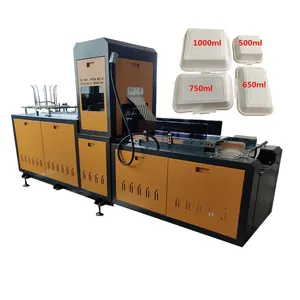(1450 products available)







































































































































































































Biodegradable tableware making machines can produce various food packaging items using material like sugarcane bagasse, wheat straw, leaves, rice husk, palm leaves, etc. These include plates, bowls, clamshells, containers, cups, molds, etc.
Semi-automatic biodegradable tableware making machine
A semi-automatic biodegradable tableware-making machine requires some manual input to produce biodegradable tableware. This type of machine generally consists an operation system that controls the temperature and pressure, a forming mold for the tableware, and a feeding mechanism to distribute the raw material evenly onto the mold. The operator manually feeds the raw material into the machine, which is then heated and pressed into the desired shape using the forming mold. After pressing, the operator removes the molded tableware from the machine. Compared with fully automatic machines, semi-automatic machines are usually more affordable and simpler to operate. However, they have lower production efficiency.
The automatic biodegradable tableware making machine
An automatic biodegradable tableware-making machine can produce biodegradable tableware such as plates, bowls, and containers independently and continuously without manual input. The working processes of an automatic machine, including feeding, heating, press forming, cooling, and demolding, all happen automatically. This type of machine usually has a conveyor belt that constantly feeds raw material into the molding part. Then, the heated mold presses and forms the material into the desired biodegradable tableware. After that, the tableware is ejected and transferred to the next position by the cooling device or conveyor belt. Because all the work processes are completed automatically, an automatic biodegradable tableware-making machine has a higher production efficiency than semi-automatic ones. Moreover, it is easier to achieve stable and precise production.
Combined biodegradable tableware making machine
The combined biodegradable tableware-making machines can make different kinds of biodegradable tableware by changing the specific parts of the machine, such as the feeding mechanism, forming mold, cooling device, and others. It is highly versatile and can provide custom solutions for business buyers.
These are a few key specifications of biodegradable tableware making machines. There may be more depending on the type and model of the machine.
Biodegradable tableware machines can make various types of biodegradable tableware for business buyers. The following are some of the uses of these machines.
The most common use of a biodegradable tableware machine is to produce biodegradable plates of different shapes and sizes. The machines provide a cost-effective way of producing both large and small biodegradable plates. Business buyers can purchase machines that produce large quantities of plates per hour.
Aside from plates, biodegradable cup and container production is another common use of the machine. It produces both hot and cold cups to suit various industries and applications. Most biodegradable cups and containers have a waterproof coating that prevents leakage and maintains structural integrity when containing liquid or moisture. Business buyers can get customized designs and sizes to meet niche market demands.
Value-added products like straws, cutlery, and trays can be produced using a biodegradable tableware machine. These items are often produced alongside biodegradable plates and cups to create a complete tableware set for customers.
The machine can also produce biodegradable food packaging solutions like clamshells, cartons, and containers. The produced items are typically used in the food service, restaurant, and catering industry. These biodegradable packaging solutions help business owners reduce their environmental impact and meet customer demand for sustainable packaging options.
Before investing in Biodegradable Tableware Making Machines, it's crucial to conduct demand analysis. Understand the types of biodegradable tableware that people demand in the local market, such as paper pulp, PLA, or composite pulp. Moreover, identify the materials used in the desired tableware so that the machine chosen is compatible with them.
Also, analyze the production capacity required. Businesses with high volumes of demand may need a machine with a large production capacity, while those with low volumes can choose machines with a small production capacity. It is also important to consider the level of automation of the machine. Fully automated machines are more convenient and faster than partially automated ones, but they may cost more.
Investigate the eco-friendly features of the machine such as energy-saving modes, efficient production techniques, and minimal waste generation. Also, examine the consistency and quality of the samples produced by the machine. When possible, test the machine before buying to ensure it meets the expected standards. The maintenance requirements of the machine should also be analyzed. In general, biodegradable tableware machines require regular maintenance to ensure optimal performance and increase their lifespans.
The production cost per unit of tableware should be analyzed when choosing a biodegradable tableware making machine. The selected machine should help produce the tableware at a low cost so that users can enjoy higher profit margins. Understand the operating requirements of the machine, including the skills and knowledge needed to operate it effectively. It's also essential to consider the compatibility of the chosen machine with other production equipment, such as drying and pressing machines.
Finally, get to know the supplier's after-sales support and service. They should provide technical support, spare parts supply, repair services, etc. Also, ensure that the chosen machine complies with local regulations and standards to avoid legal issues in the future.
Q1: Are biodegradable tableware-making machines eco-friendly?
A1: Biodegradable tableware-making machines are eco-friendly because they reduce reliance on plastic and contribute to environmental sustainability.
Q2: Can the biodegradable tableware-making machine be customized?
A2: Most biodegradable tableware-making machines can be customized to produce specific types of tableware shapes and sizes.
Q3: What is the production capacity of the biodegradable tableware-making machine?
A3: The production capacity varies depending on the machine size and model, ranging from a few hundred to several thousand pieces per hour.
Q4: Is the biodegradable tableware-making machine automated or manual?
A4: Biodegradable tableware-making machines are usually automated for increased efficiency and productivity, but some manual parts may exist.